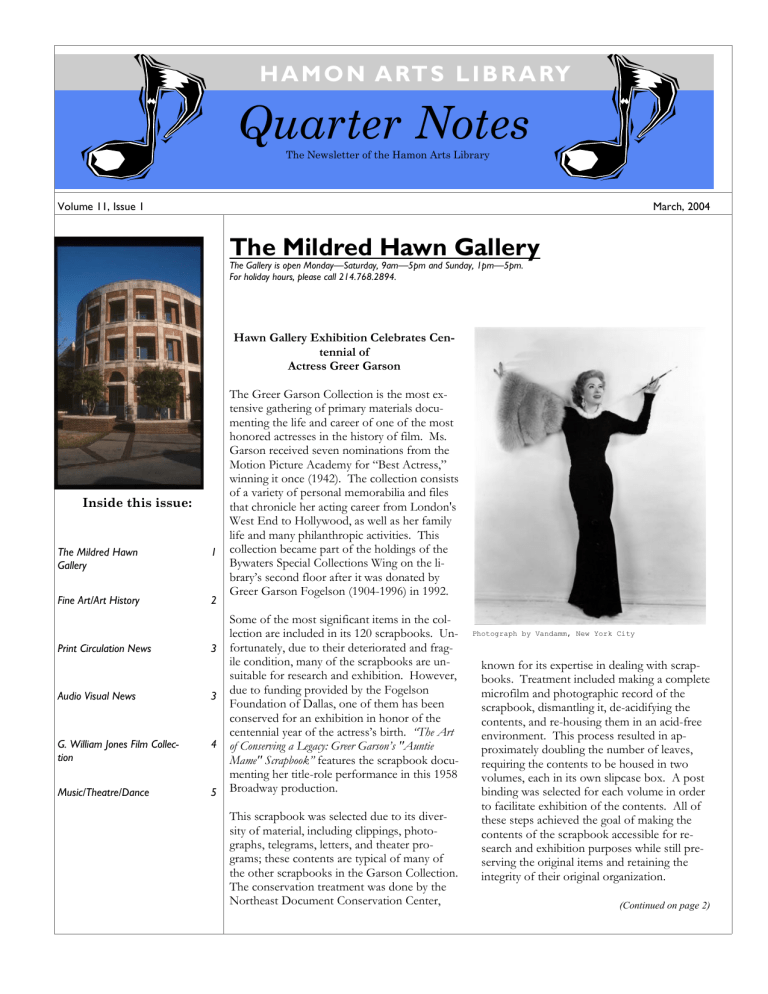Quarter Notes
advertisement

H A M O N A RT S L I B R A RY Quarter Notes The Newsletter of the Hamon Arts Library Volume 11, Issue 1 March, 2004 The Mildred Hawn Gallery The Gallery is open Monday—Saturday, 9am—5pm and Sunday, 1pm—5pm. For holiday hours, please call 214.768.2894. Hawn Gallery Exhibition Celebrates Centennial of Actress Greer Garson Inside this issue: The Mildred Hawn Gallery 1 Fine Art/Art History 2 Print Circulation News 3 Audio Visual News 3 G. William Jones Film Collection 4 Music/Theatre/Dance 5 The Greer Garson Collection is the most extensive gathering of primary materials documenting the life and career of one of the most honored actresses in the history of film. Ms. Garson received seven nominations from the Motion Picture Academy for “Best Actress,” winning it once (1942). The collection consists of a variety of personal memorabilia and files that chronicle her acting career from London's West End to Hollywood, as well as her family life and many philanthropic activities. This collection became part of the holdings of the Bywaters Special Collections Wing on the library’s second floor after it was donated by Greer Garson Fogelson (1904-1996) in 1992. Some of the most significant items in the collection are included in its 120 scrapbooks. Unfortunately, due to their deteriorated and fragile condition, many of the scrapbooks are unsuitable for research and exhibition. However, due to funding provided by the Fogelson Foundation of Dallas, one of them has been conserved for an exhibition in honor of the centennial year of the actress’s birth. “The Art of Conserving a Legacy: Greer Garson’s "Auntie Mame" Scrapbook” features the scrapbook documenting her title-role performance in this 1958 Broadway production. This scrapbook was selected due to its diversity of material, including clippings, photographs, telegrams, letters, and theater programs; these contents are typical of many of the other scrapbooks in the Garson Collection. The conservation treatment was done by the Northeast Document Conservation Center, Photograph by Vandamm, New York City known for its expertise in dealing with scrapbooks. Treatment included making a complete microfilm and photographic record of the scrapbook, dismantling it, de-acidifying the contents, and re-housing them in an acid-free environment. This process resulted in approximately doubling the number of leaves, requiring the contents to be housed in two volumes, each in its own slipcase box. A post binding was selected for each volume in order to facilitate exhibition of the contents. All of these steps achieved the goal of making the contents of the scrapbook accessible for research and exhibition purposes while still preserving the original items and retaining the integrity of their original organization. (Continued on page 2) PAGE 2 QU AR TER NOTES V OLU ME 1 1, I SSUE 1 (Continued from page 1) “The Art of Conserving a Legacy: Greer Garson’s: "Auntie Mame Scrapbook” opened to the public on January 23, with a special reception featuring Dr. Ronald L. Davis, who described Garson through the eyes of her show business contemporaries. Davis is professor emeritus of history at SMU and the author of numerous books, including Glamour Factory: Inside Hollywood's Big Studio System (1983) and Van Johnson: MGM's Golden Boy (2001). The exhibition closes on Sunday, March 7. Gallery hours are Monday through Friday from 8 a.m. to 5 p.m., Saturday from 9 a.m. to 5 p.m. and Sunday from 1 p.m. to 5 p.m.. The Mildred Hawn Gallery is located on the first floor of the Hamon Arts Library. Fine Art/Art History Fine Arts News – A Review American Women Photographers: A Selected and Annotated Bibliography. Martha Kreisel. Westport, Conn. Greenwood Press, 1999. Hamon Library, Reference TR139. K74 1999 The Hamon Arts Library is proud to add American Women Photographers: A Selected and Annotated Bibliography to our reference collection. American women have made significant contributions to the field of photography for well over a century. As women's role in society changed, so did their role as photographers. No longer confined to serving as assistants in their husbands' studios, women photographers became journalists and portraitists. As the publisher notes, “The photography equipment, initially heavy and difficult to transport, was improved in the 1880s by George Eastman's innovations. With the lighter camera equipment, photography became accessible to everyone. Women photographers became journalists and portraitists who documented vanishing cultures and ways of life.” These photographers, mainly concentrated in the Northwest and New York, were instrumental in their efforts to document the plights of Americans fleeing the Dust Bowl, documenting the horrors of the concentration camps, and were members of the Photo-Secessionist Movement to promote photography as a legitimate art form. “Patrons interested in photography, women’s studies, or American cultural history will find this reference book a useful supplement to the library’s extensive reference collection.” This reference work includes 1073 references to monographs, exhibition catalogs, periodicals, dissertations, and video recordings. It covers 600 women photographers from the 1880s to the present. lowed by an explanation of the abbreviations and notations used in the book. The main section is arranged alphabetically by photographer, and includes cross-references to a separate section, "Bibliography of Collected Works of American Women Photographers." These two sections are followed by two extensive indices, one of authors and one of sources. Patrons interested in photography, women’s studies, or American cultural history will find this reference book a useful supplement to the library’s extensive reference collection. This exciting new reference volume is housed on the first floor of the Hamon Art’s Library Reference Collection and is available for in library use only. -- J. Brandon Pope Fine Arts Librarian The single volume of this reference work is laid out with first an introduction fol- Favorite Art/Art History Research Websites • • • • http://www.smu.edu/cul/hamon/research/artindex.htm http://www.smu.edu/cul/hamon/research/reference/artdict.html http://www.groveart.com/index.html http://www.smu.edu/cul/or/Indexes_Art_History_and_Art.html. QU AR TER NOTES VOLU ME 11 , ISSUE 1 PAGE 3 Print Circulation SPRING 2004 achieve the most from your academic endeavors. Please remember that we are doing all we can at the Hamon Arts Library to If at anytime, you have concerns or questions about our library, improve patron services. We have installed suggestion boxes at the Circulation and Reference desks for your comments. A few other things you can do to help us serve you better: FOOD FOR FINES 2003 Amidst a stressful final exam week and thoughts of going home for the semester break, students still managed to bring more than 600 canned food items. During the two-week campaign, students can bring in non-perishable food items to help the North Texas Food Bank while clearing their accounts of outstanding late fees. · Familiarize yourself with Hamon circulation policies such as: check out periods, on-line renewals, study rooms, and fines and fees. · Make sure all Reserve materials are brought back diplease feel free to contact any rectly to the student assistants member of the Hamon Library at circulation desk for proper staff. check-in. Thank you and have a wonderful Faculty: Please pick up old semester. Reserve items · · Chris Leamy Try to keep noise levels down Head of Circulation Services to a minimum. · Remove all bookmarks and sticky notes from items before check-in. · Please aim questions about searching the catalog, using reference tools, or search strategies to the Reference & Information desk or ask Hamon librarians. · Report any perceived problems in the stacks or with library items to Hamon staff. Our goal is to provide the highest possible level of service to help you Audiovisual News Bass Notes The view from the A / V Center You may have noticed we have changed the configuration of the information commons slightly. The computers are now located on the top shelves of the carrels to allow for easier access to the USB ports. Additionally, this will reduce damage to the machines from pulling and dragging. Moving from a traditional listening / viewing center to a full service multimedia environment takes time—not the least of which is the time it takes to configure the physical layout for optimal efficiency. Please bear with us as we experiment to find the best set up to serve you. If you have any questions, concerns, or suggestions for the new configuration please feel free to approach me. Daniel M. Delgado PAGE 4 QU AR TER NOTES V OLU ME 1 1, I SSUE 1 G. William Jones Film Collection The G. William Jones Film and Video Collection is extremely fortunate in having an outstanding student worker this year. Jon Peterson, a candidate for a Master’s Degree in Choral Conducting (2005), has demonstrated a unique grasp on the film collection and its policies and has been extremely valuable in making use of his organizational skills. Jon has completely reorganized the former film laboratory, making it easily acceptable for the actual hands-on film use that is required. (Over time, the lab had become somewhat disorganized and cluttered. Material stored in the space prevented the room from being used to its full advantage).. Jon saw this stored material as useful and consequently has organized the film equipment around this material, thus making a useable lab room. Jon also undertook and completed a complete inventory of the ½ inch video tapes. There are now 1,397 videos in the collection. This collection is enhanced quarterly by a donor, and the following is a list of titles added since the last report: The Ghoul The Prince and the Pauper The Mystery of the Wax Museum Umberto D. Giant Anastasia Salome The Tempest Hiroshima, Mon Amour Sleeping beauty The Mark of Zorro The Man Who Laughs The Devil and Daniel Webster The Adventures of Robin Hood Treasure of Sierra Madre Knife in the Water Yankee Doodle Dandy The Marriage of Maria Braun The Jolson Story Scarface Speedy Gonzalez’ Funnies Porky Pig’s Comedies Road Runner V. Wile E. Coyote A Salute to Mel Blanc Daffy Duck: The Nuttiness Continues Sylvester & Tweety’s Crazy Capers Pepe Le Pew’s Skunk Tales Elmer Fudd’s Comedy Capers Foghorn Leghorn’s Fractured Funnies Applause Love Me Tonight La Strada The Unknown In addition to these titles the donor also contributed on DVD the following: Phantom of the Opera The Great Dictator Modern Times The Gold Rush Jon also undertook an identification and inventory project on the Lloyd Pfautsch music collection (reel-to-reel and audiocassette). The completion of this project has enabled the start of a project that is currently transferring many of our reel-to-reel all the Pfautsch recordings of music concerts to a CD format, the Lloyd Pfautsch Memorial Recording Project. Jon and the film archivist Robert Eason are currently working on compiling all the unidentified 16 mm films in the vault. Once they are all in a holding area we will begin to identify the films and place them in such an order that they will be ready for future cataloguing and adding to the collections holdings. The DVD boxed set of the Tyler, Texas films is currently available for purchase. The order form can be found on the Internet at: www.smu.edu/blackfilms/orderform.pdf. --Respectfully submitted, Robert Eason, Film and Video Archivist VOLU ME 11 , ISSUE 1 QU AR TER NOTES Music/Theatre/Dance From February 10th-15th, I attended the Music Library Association annual meeting in Washington, D.C. As was appropriate considering the location of the conference, many presentations involved activities and collections at the Library of Congress. I attended a lengthy tour of the areas of the Library of Congress inaccessible to the public, including their audio-visual preservation labs, score and book preservation departments, music cataloging, and copyright offices. (Having toured the area for two and a half hours compels me to mention that we should never take our beautiful windows in the Hamon for granted!) In addition to learning about many of the procedures in place at our nation’s Library, I also attended many sessions on national library initiatives, including issues such as copyright law and digital library collections and systems. One new resource discussed at the conference that I would like to mention is the newly launched “I Hear America Singing” website from the Performing Arts Reading Room of the Library of Congress. Available at http://www.loc.gov/rr/perform/ ihas/, the fledgling website features the Library’s collection of more than 9,000 titles of historic sheet music from 1800-1922, including songs by Irving Berlin and Jerome Kern. Other highlights on the site are a special presentation on patriotic songs, including images of early sheet music publications and sound recordings, and an extraordinarily thorough presentation of the Gerry Mulligan Collection, which includes an oral autobiog- raphy, photographs of the composer/ arranger/jazz musician, recordings, and even printable music for use in performing his works. The website was just launched at the beginning of February and will continue to expand in scope, so check back often! On a more businesslike note, we hope to be participating in the WisconsinOhio Reference Evaluation Program (WOREP) in the coming months. As a follow-up to the same study we participated in several years ago, we hope to evaluate our reference services in order to provide the highest quality service to our patrons. The study is endorsed and paid for by the Music Library Association, and our participation in this study will help the Music Library Association establish assessment standards for music libraries throughout the country. The results of the study will enable comparison between academic music libraries in order to determine the most successful procedures for effective reference services. Look for the surveys when you ask a reference question soon, and thanks so much for your support and helpful participation in our quest towards being the best Hamon we can be! Alisa Rata Music, Theater, and Dance Librarian arata@smu.edu 214 768-1856 PAGE 5 Look What’s in the Information Commons As promised in our last issue, check out these images of our newest equipment! These machines will be dedicated to students requiring high-end video & audio computing power “We at the Hamon Library are devoted to providing the best equipment possible for our patron’s use; we will continue to upgrade and refine our services as budgets permit” -Daniel M. Delgado The Hamon Arts Library is located in the Meadows HAMON ARTS LIBRARY School of the Arts, which centers on the study, crea- Hamon Arts Library Meadows School of the Arts P.O. Box 750356 Dallas, TX 75275 Phone: 214.768.2894 Email: hamonadmin@smu.edu tion, and analysis of the visual, performing, and communication arts at the undergraduate and graduFax: 214.768.1800 ate levels within a liberal arts environment. And, as a branch of the Central University Libraries (CUL), we encourage you to visit their website (http://www. smu.edu/cul) to take full advantage of the myriad re- Hamon Arts Library sources available. We’re On The Web! Http://www.smu.edu/cul/hamon CURRENT ATTRACTIONS!! The DVD boxed set of the Tyler, Texas films is currently available for purchase. The order form can be found on the Internet at: www.semu.edu/blackfilms/



